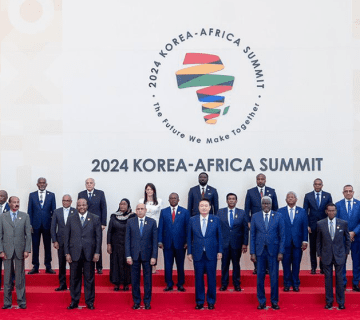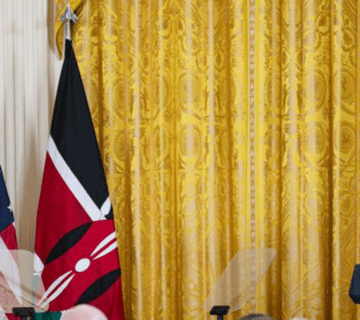A part of the motion co-sponsored by Kenya’s National Assembly Majority and Minority Leaders, Aden Duale and John Mbadi respectively, reads:
“…this House resolves that the Government of the Republic of Kenya explores other lawful and constitutional mechanisms for protecting the territory of the Republic, including deploying the Kenya Defence Forces to the subject boundary to undertake the responsibility of protecting the sovereignty and territorial integrity of the Republic as contemplated under Article 241(3) of the Constitution.”
The motion is likely to be debated once the House resumes its sitting, and if adopted, Kenya is likely to deploy her Navy, to the maritime territory in dispute with Somalia. However, it is worth noting that the dispute between Kenya and Somalia over a 100 km² of maritime triangle in the Indian Ocean, is currently before the International Court of Justice (ICJ) for determination. This possible move by Kenya raises questions regarding the effectiveness and limits of deployment of the military, insofar as the country’s territorial integrity is concerned, in reference to the maritime territory at stake.
The principles of effectivités and effective occupation
In principle, effectivités is used in legal argumentation to ground claims to sovereignty over a hitherto ‘undetermined’ territory (not necessarily terra nullius), while ‘effective occupation’ is its political equivalent used to assert a state’s claim to sovereignty over a territory. Proof of ‘effective occupation’ arises from a history of actions or conduct by a state over the territory in question, which translate to effective exercise of sovereignty of such territory.
Similarly titles, treaties, and historical documents including maps, also have legal interpretative value in judicial conferment of sovereignty over a disputed territory to a state. Such actions or conduct may include military and political control of the territory in question and granting or refusing to grant permission for such conduct. Further, positioning of a state’s emblem over the territory expresses such a state’s exercise of sovereignty over the territory. When the third state by acquiescence or tacit and formal recognition acknowledges a state’s emblem, exercise of control, and respects grants or refusal of grants for activities in the territory, such conduct further ‘confirms’ effective occupation.
On the other hand, titles such as treaties ceding sovereign control of such maritime territory by the former ‘occupying or controlling’ power, are used to ground claims of sovereignty over such maritime territory.
In the maritime dispute between Malaysia and Singapore, for instance, sovereignty over Pedra Branca was granted to Singapore by the ICJ in 2008, for among other reasons, the absence of reaction from Malaysia and thus acquiescence on the part of Malaysia, to the flying of the Singapore ensign on the island, the installation by Singapore of military communications equipment on the island in 1977, and the proposed reclamation plans by Singapore to extend the island, as well as a few specific publications and maps.
Limits to Kenya’s Military Strategy
Thus, Kenya will vainly prove effectivités or ‘effective occupation’ by deploying the military in the coming months, to the disputed maritime zone. This is simply because such military occupation will have happened after the fact. Associated military activities such as patrolling, do not satisfactorily prove effective occupation and control nor effective exercise of sovereignty, on the part of Kenya. Nonetheless, deploying the military will certainly prove effective for Kenya, if the ICJ ruling will be favorable to its position in the matter.
However, continued military occupation by Kenya of the disputed zone contrary to the ICJ ruling (if unfavorable) will test the limits of force. This is because the legitimacy of occupation will be untenable in the face of a contrary ruling or award, and will thence transform the dispute into a conflict, since Somalia will seek to exercise its rights over the territory – a mutually exclusive reality. The event of continued military occupation, despite a contrary ruling by the court, will in principle, imply non-observance of international law and the United Nations Charter promoting peaceful international relations and peaceful resolution of disputes. This might compel the United Nations Security Council (UNSC) to intervene in the interest of peace and security – or Somalia to respond in kind – with the dispute further escalating into a conflict. It is potentially tempting for other sub-national groups and international actors (Somalia’s allies) to get involved in the matter, as it spans into a conflict. Such groups might include nationalistic militant groups in Somalia such as al Shabab.
The Bottom-line
Thus, for Kenya to deploy the military to the disputed maritime zone, it must assess its power capabilities against that of Somalia, so as not to over-estimate the disequilibrium between the two countries in its advantage. In this regard, Kenya should accurately aggregate Somalia’s actual and potential power (Somalia’s alliance system), and the interest of intervening elements such as al Shabab in the matter, against its own national power to preserve its territorial integrity by all means including the use of force. Further, Kenya should assess its ability to hold out against an ICJ ruling, the UN Security Council, and fluidity of the conflict in terms of actors, scale and interests. Similarly, Kenya should assess the possible impact of conflict on its national security, diplomatic standing, and regional stability. Proper re-examination of military occupation will inform strategic deployment, which might save the country’s decision-makers from losing face. It is worth noting that the maritime dispute between Kenya and Somalia will not be effectively decided by military power but legal and political ingenuity, at least at this stage.
Nigeria, for instance, occupied the Bakassi Peninsula in 1993 in its dispute with Cameroon over sovereignty over the Peninsula. A ruling by the ICJ in 2002 was unfavorable to Nigeria, as it granted sovereignty over the Bakassi Peninsula to Cameroon. A process begun in 2006 to have Nigeria cede Bakassi to Cameroon and the final agreement was signed between Nigeria and Cameroon in 2008 for transfer of the Peninsula to Cameroonian sovereignty. Military occupation as a policy employed by Nigeria in the Bakassi Peninsula caused a limited armed conflict between Cameroon and Nigeria and failed to achieve its intended objectives. The period between 2006 and 2008 was largely a face-saving window for Nigeria, as military withdrawal became inevitable in the face of efforts by the international community to end the conflict and ensure implementation of the 2002 ICJ ruling.
Edmond J. Pamba is a Research Assistant at the HORN Institute.
Photo: Kenya Navy KNS Jasiri offshore patrol vessel in Mombasa in 2012 (Photo Credit: Kenya Defence Forces)



